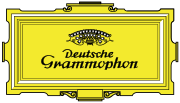Deutsche Grammophon

Deutsche Grammophon is a German classical music record label that was the precursor of a corporation called PolyGram. It is now part of Universal Music Group (UMG) since its merger with the UMG family of labels in 1999. It is the oldest surviving established record company. Deutsche Grammophon Gesellschaft was founded in 1898 by German-born United States citizen Emile Berliner as the German branch of his Berliner Gramophone Company. Berliner sent his nephew Joseph Sanders from America to set up operations. Based in the city of Hanover (the founder's birthplace), the company was an affiliate of the U.S. Victor Talking Machine Company and the British Gramophone Company, but that affiliation ended with the onset of World War I. Early labels bore the legend Grammophon and the painting "His Master's Voice" featuring the dog Nipper. In 1941, Deutsche Grammophon was purchased by the Siemens & Halske electronics company. In 1949, Deutsche Grammophon sold the German rights of the His Master's Voice trademark to the Electrola unit of EMI. The dog and gramophone were replaced by the crown of tulips, designed by Siemens advertising consultant Hans Domizlaff. In 1962 Siemens formed a joint venture with Netherlands-based Philips to create the DGG/PPI Record Group, which became PolyGram Records in 1972. Deutsche Grammophon pioneered the introduction of the compact disc to the mass market, debuting classical music performed by Herbert von Karajan and the Berlin Philharmonic for sale in the new medium in 1983.
Prokofiev: Piano Concerto Nr. 3 C Major; Ravel: Piano Concerto in G Major [Vinyl]
Martha Argerich
Ravel: Bolero; Debussy: La Mer, Prelude a l'apres-midi d'un faune [Vinyl]
Herbert von Karajan
Respighi: Pines of Rome, Feste Romane, Fountains of Rome [Vinyl]
Boston Symphony (Seiji Ozawa)
Richard Strauss: Salome [Laserdisc]
Teresa Stratas, Bernard Weikl, Vienna Philharmonic (Karl Bohm).
Rodrigo: Concierto de Aranjuez, Concert Serenade for Harp; Castelnuovo-Tedesco: Guitar Concerto No 1 [Tape]
Siegfried Behrend, Nicanor Zabaleta
Salzburg Recital: Faure, Handel, Mendelssohn, Mozart, Purcell, Strauss, Spirituals [Tape]
Kathleen Battle, James Levine

![Prokofiev: Piano Concerto Nr. 3 C Major; Ravel: Piano Concerto in G Major [Vinyl] Prokofiev: Piano Concerto Nr. 3 C Major; Ravel: Piano Concerto in G Major [Vinyl]](/media/com_eshop/products/resized/YL05158-100x100.png)
![Prokofiev: Symphony No 3; Three Oranges Suite [Tape] Prokofiev: Symphony No 3; Three Oranges Suite [Tape]](/media/com_eshop/products/resized/YT01759-100x100.jpg)
![Purcell: Dido and Aeneas, The Fairy Queen, Te Deum [CD] Purcell: Dido and Aeneas, The Fairy Queen, Te Deum [CD]](/media/com_eshop/products/resized/YC08763-100x100.jpg)
![Pyotr Ilyich Tchaikovsky , Leningrad Philharmonic Orchestra Leningrader Philharmonie Evgeny Mravinsky - Symphonie Nr.4 [Vinyl] Pyotr Ilyich Tchaikovsky , Leningrad Philharmonic Orchestra Leningrader Philharmonie Evgeny Mravinsky - Symphonie Nr.4 [Vinyl]](/media/com_eshop/products/resized/YL03377-100x100.jpg)
![Rachmaninoff: Piano Concerto No 2; 6 Preludes [Vinyl] Rachmaninoff: Piano Concerto No 2; 6 Preludes [Vinyl]](/media/com_eshop/products/resized/YL06686-100x100.png)
![Rachmaninov: Concertos pour Piano Nos. 2 & 4 [Vinyl] Rachmaninov: Concertos pour Piano Nos. 2 & 4 [Vinyl]](/media/com_eshop/products/resized/YL04127-100x100.jpg)
![Rachmaninov: Klavierkonzerte - Piano Concertos 1&2 [Vinyl] Rachmaninov: Klavierkonzerte - Piano Concertos 1&2 [Vinyl]](/media/com_eshop/products/resized/YL06504-100x100.png)
![Rachmaninov: Piano Concerto No.2; Paganini Rhapsody [CD] Rachmaninov: Piano Concerto No.2; Paganini Rhapsody [CD]](/media/com_eshop/products/resized/YC09283-100x100.png)
![Rachmaninov: Piano Concertos 2 & 3 [CD] Rachmaninov: Piano Concertos 2 & 3 [CD]](/media/com_eshop/products/resized/YC14483-100x100.png)
![Rachmaninov: Symphonic Dances, Vocalise, Aleko Intermezzo [Tape] Rachmaninov: Symphonic Dances, Vocalise, Aleko Intermezzo [Tape]](/media/com_eshop/products/resized/YT01755-100x100.jpg)
![Ravel: Bolero / Mussorgsky-Ravel: Tableaux D'Une Exposition [Vinyl] Ravel: Bolero / Mussorgsky-Ravel: Tableaux D'Une Exposition [Vinyl]](/media/com_eshop/products/resized/YL01087-100x100.png)
![Ravel: Bolero [CD] Ravel: Bolero [CD]](/media/com_eshop/products/resized/YC08333-100x100.jpg)
![Ravel: Bolero, La Valse, Rapsodie Espagnole [Tape] Ravel: Bolero, La Valse, Rapsodie Espagnole [Tape]](/media/com_eshop/products/resized/YT00756-100x100.jpg)
![Ravel: Bolero; Debussy: La Mer, Prelude a l'apres-midi d'un faune [Vinyl] Ravel: Bolero; Debussy: La Mer, Prelude a l'apres-midi d'un faune [Vinyl]](/media/com_eshop/products/resized/YL05246-100x100.png)
![Ravi Shankar & Alla Rakha: Ragas Talas Improvisation [Tape] Ravi Shankar & Alla Rakha: Ragas Talas Improvisation [Tape]](/media/com_eshop/products/resized/YT02303-100x100.jpg)
![Respighi: Ancient Airs & Dances [Tape] Respighi: Ancient Airs & Dances [Tape]](/media/com_eshop/products/resized/YT00757-100x100.jpg)
![Respighi: Fontane di Roma [Vinyl] Respighi: Fontane di Roma [Vinyl]](/media/com_eshop/products/resized/YL02462-100x100.jpg)
![Respighi: Pines of Rome, Feste Romane, Fountains of Rome [Vinyl] Respighi: Pines of Rome, Feste Romane, Fountains of Rome [Vinyl]](/media/com_eshop/products/resized/YL02667-100x100.png)
![Richard Strauss: Also Sprach Zarathustra [Vinyl] Richard Strauss: Also Sprach Zarathustra [Vinyl]](/media/com_eshop/products/resized/YL03299-100x100.jpg)
![Richard Strauss: Ein Heldenleben [Vinyl] Richard Strauss: Ein Heldenleben [Vinyl]](/media/com_eshop/products/resized/YL01433-100x100.jpg)
![Richard Strauss: Festival of Hits [Vinyl] Richard Strauss: Festival of Hits [Vinyl]](/media/com_eshop/products/resized/YL06493-100x100.png)
![Richard Strauss: Salome [Laserdisc] Richard Strauss: Salome [Laserdisc]](/media/com_eshop/products/resized/YD10009a-100x100.jpg)
![Rimsky Korssakoff Scheherazade [Vinyl] Rimsky Korssakoff Scheherazade [Vinyl]](/media/com_eshop/products/resized/YL02460-100x100.jpg)
![Rimsky Korssakoff Scheherazade [Vinyl] Rimsky Korssakoff Scheherazade [Vinyl]](/media/com_eshop/products/resized/YL03222-100x100.jpg)
![Rimsky-Korsakov: Scheherazade [Vinyl] Rimsky-Korsakov: Scheherazade [Vinyl]](/media/com_eshop/products/resized/YL05561-100x100.png)
![Robert Schumann: Fantasie C-Dur in C Major Op. 1, Sonate Fis-Moll (in F Sharp Minor) Op. 11 [Vinyl] Robert Schumann: Fantasie C-Dur in C Major Op. 1, Sonate Fis-Moll (in F Sharp Minor) Op. 11 [Vinyl]](/media/com_eshop/products/resized/YL02660-100x100.png)
![Robert Schumann: Symphonie Nr. 1 ,Fruhling, Symphonie Nr. 4 [Vinyl] Robert Schumann: Symphonie Nr. 1 ,Fruhling, Symphonie Nr. 4 [Vinyl]](/media/com_eshop/products/resized/YL03269-100x100.jpg)
![Rodrigo: Concierto de Aranjuez and Seranade [Vinyl] Rodrigo: Concierto de Aranjuez and Seranade [Vinyl]](/media/com_eshop/products/resized/YL01170-100x100.jpg)
![Rodrigo: Concierto de Aranjuez, Concert Serenade for Harp; Castelnuovo-Tedesco: Guitar Concerto No 1 [Tape] Rodrigo: Concierto de Aranjuez, Concert Serenade for Harp; Castelnuovo-Tedesco: Guitar Concerto No 1 [Tape]](/media/com_eshop/products/resized/YT02619-100x100.jpg)
![Rodrigo: Concierto de Aranjuez, Fantasia Para Un Gentilhombre [Tape] Rodrigo: Concierto de Aranjuez, Fantasia Para Un Gentilhombre [Tape]](/media/com_eshop/products/resized/YT01096-100x100.jpg)
![Romance [CD] Romance [CD]](/media/com_eshop/products/resized/YC15161-100x100.png)
![Rossini: Ouverturen [Vinyl] Rossini: Ouverturen [Vinyl]](/media/com_eshop/products/resized/YL02355-100x100.jpg)
![Saint-Saens, Cello Concertos, Burch: Kol Nidrei [CD] Saint-Saens, Cello Concertos, Burch: Kol Nidrei [CD]](/media/com_eshop/products/resized/YC09805-100x100.jpg)
![Saint-Saens: Violin Concerto No 3; Wieniawski: Violin Concerto No. 2 [Tape] Saint-Saens: Violin Concerto No 3; Wieniawski: Violin Concerto No. 2 [Tape]](/media/com_eshop/products/resized/YT00503-100x100.jpg)
![Salzburg Recital: Faure, Handel, Mendelssohn, Mozart, Purcell, Strauss, Spirituals [Tape] Salzburg Recital: Faure, Handel, Mendelssohn, Mozart, Purcell, Strauss, Spirituals [Tape]](/media/com_eshop/products/resized/YT00500-100x100.jpg)
![Sandor Konya Singt Opernarien (Sandor Konya Recital) [Vinyl] Sandor Konya Singt Opernarien (Sandor Konya Recital) [Vinyl]](/media/com_eshop/products/resized/YL00960-100x100.jpg)
![Scarlatti: Sonatas [CD] Scarlatti: Sonatas [CD]](/media/com_eshop/products/resized/YC14955-100x100.png)
![Schubert: Selected Piano Works [Vinyl] Schubert: Selected Piano Works [Vinyl]](/media/com_eshop/products/resized/YL06679-100x100.png)
![Schubert: Compositions for Piano Duet [Vinyl] Schubert: Compositions for Piano Duet [Vinyl]](/media/com_eshop/products/resized/YL02871-100x100.jpg)
![Schubert: Die Schone Mullerin [Vinyl] Schubert: Die Schone Mullerin [Vinyl]](/media/com_eshop/products/resized/YL01362-100x100.jpg)
